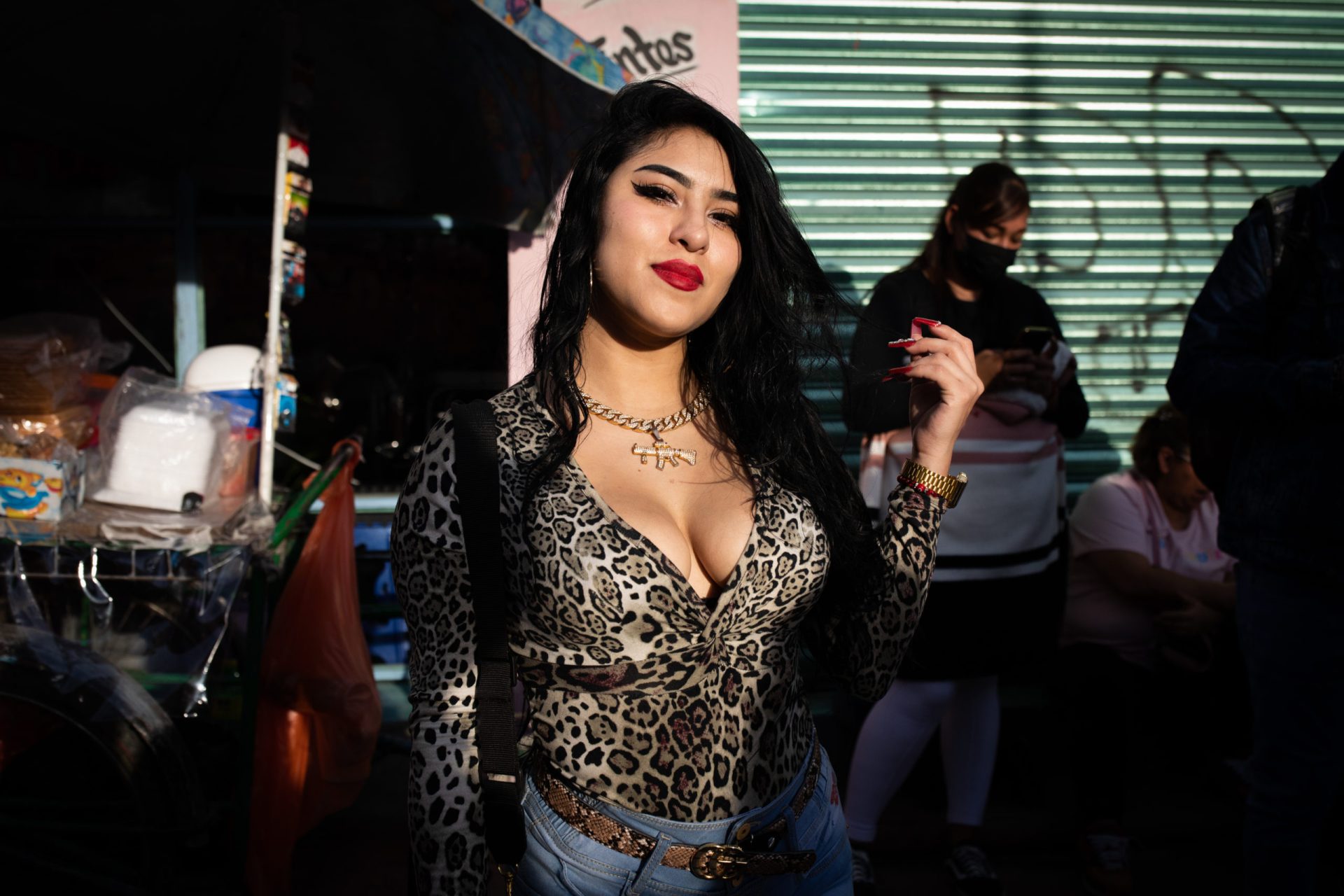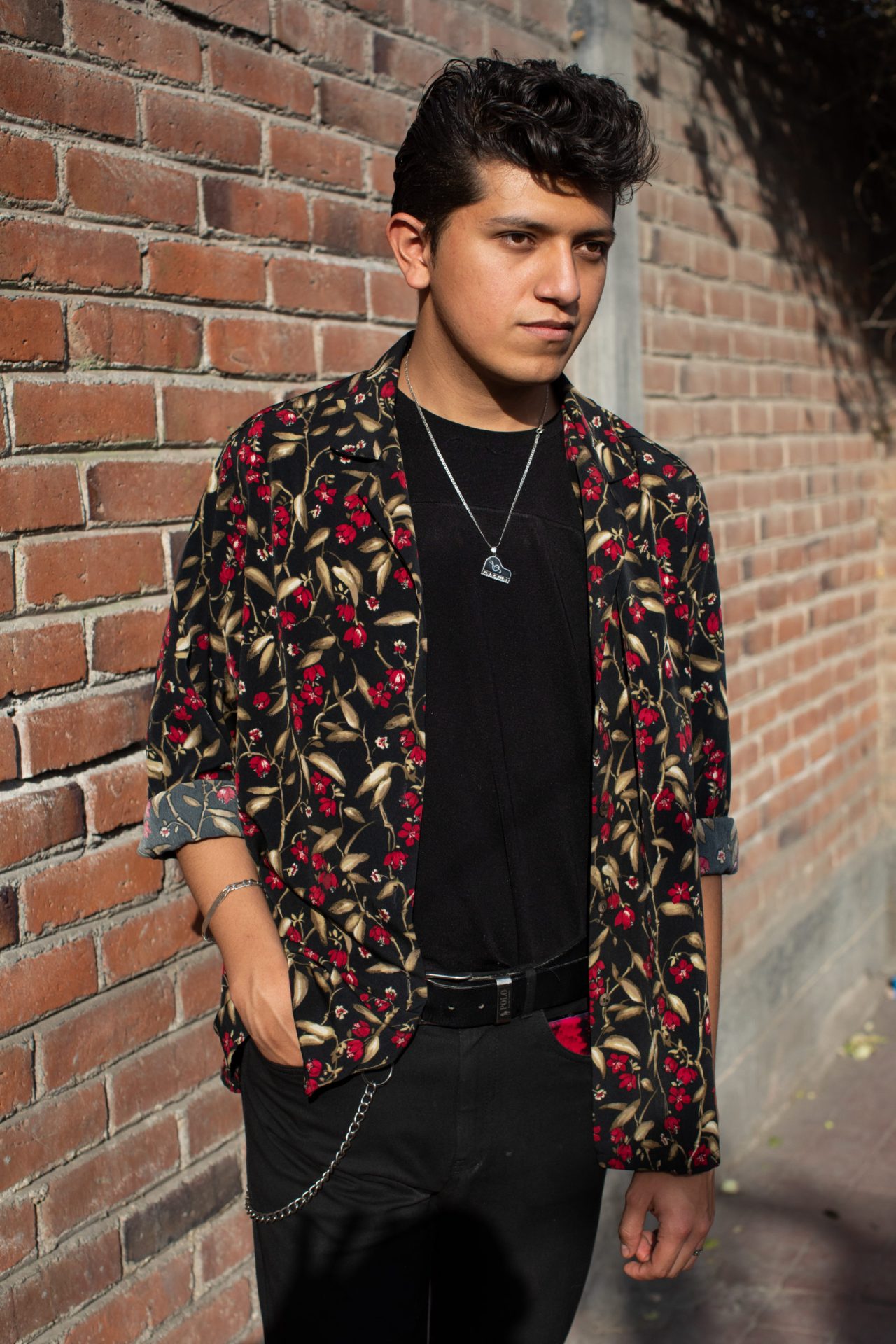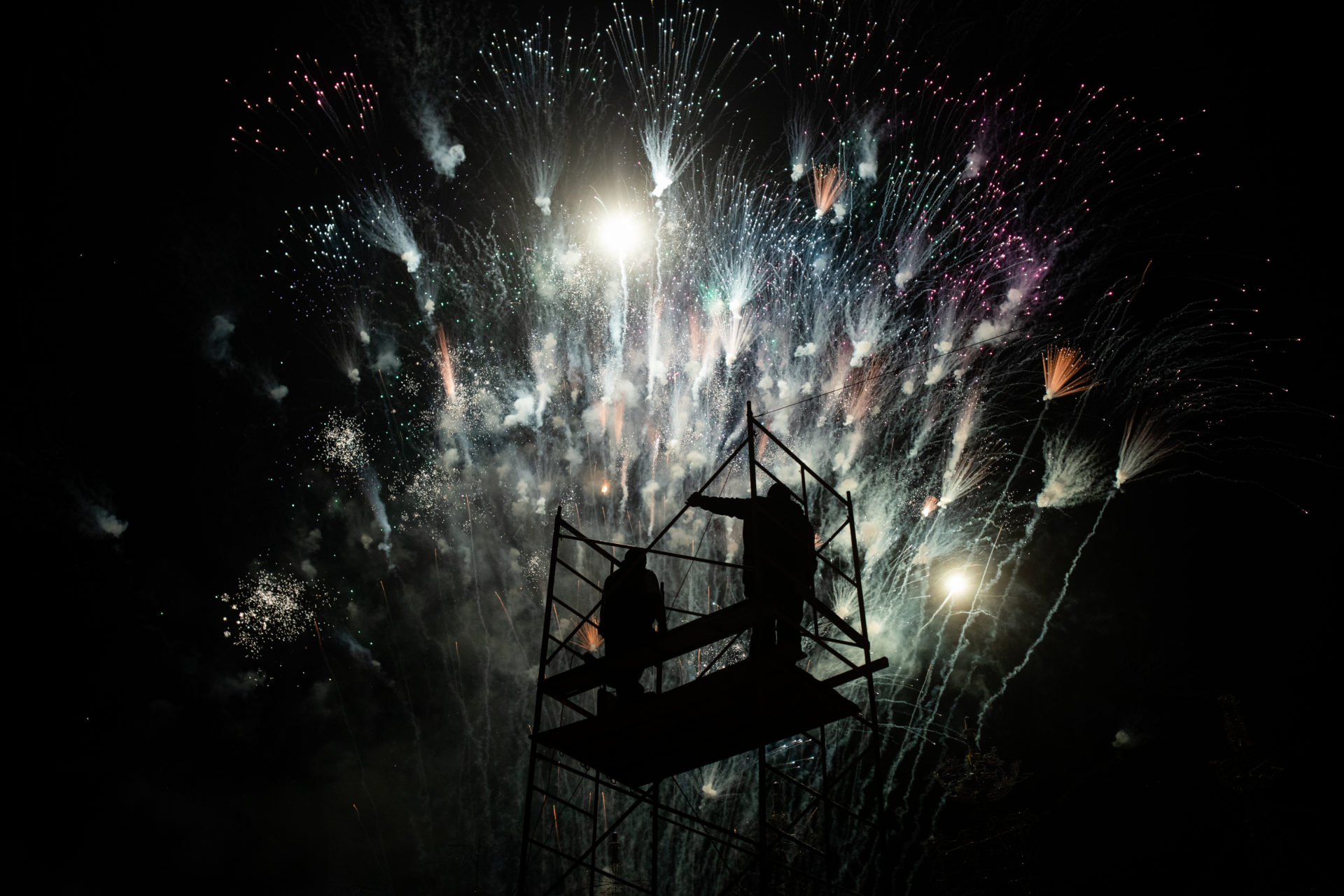 March 5, 2022 – Two technicians look on from a scaffolding at the Castillos competition
March 5, 2022 – Two technicians look on from a scaffolding at the Castillos competition
By Lisette Poole
“You light the fuse, and then, you run,” says Dulce María Urbán, 39, a nurse from Tultepec, Mexico. “Pure adrenaline,” she says, as the six brass instruments and two drums playing polka music next to her almost drown out her high-pitched cheerful voice.
On March 8 this year, thousands of people filled the narrow streets of downtown Tultepec for the first time since the pandemic started in 2020. Couples carrying micheladas —plastic cups full of beer oozing red chamoy sauce from the rim— pushed their way through crowds, balloon vendors and a man selling homemade potato chips, they called out to friends over live Banda music while people partner-danced in the street. Then, they licked the bitter red goo dripping onto their fingers and welcomed in the sweet anesthesia that would soften the blow of what was to come.
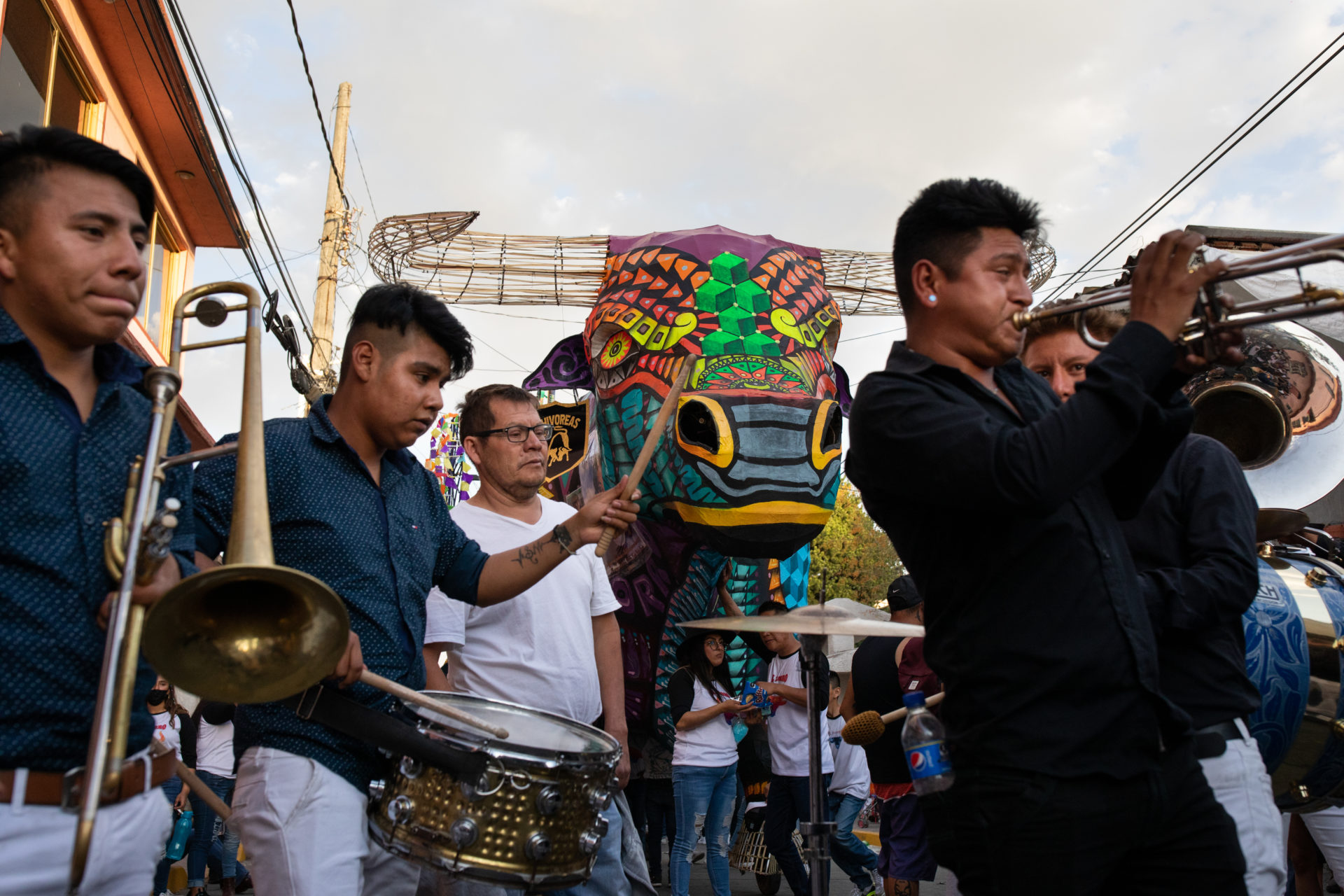
March 8, 2022 – El Zorro and a Banda group on the streets of Tultepec before the quema.
It is the day of toros during Tultepec’s annual International Pyrotechnics Festival, Dulce is accompanied by her large extended family, her friends and “El Zorro”, a 5 meter-tall paper maché bull covered in fireworks. By the end of the night she and her family will light El Zorro’s fuse, setting off the over two thousand fireworks or cuetes strapped to his ornately painted flank. Luckily, she said, no one in her family was hurt this year, “we were more tranquilos” usually the people who are injured, “los borrachitos,” she says.
It is the feast day of San Juan de Dios (John of God) and according to Dulce, “the most important day of the year”. It’s the yearly “Toros Pirotecnicos” event in Tultepec —think something like Pamplona’s running of the bulls but on fire.
Fireworks are Tultepec’s largest industry, “everyone is related to the trade either directly or indirectly” says Dulce. Just 42 km north of Mexico City, the town produces 60-80% of the entire country’s fireworks per year. Dulce herself comes from a lineage of women making cuetes and learned to carry on the tradition from her parents as a small child.
The day Dulce and her family made their way through the streets of Tultepec, over 50,000 women simultaneously led a very different demonstration in Mexico City. March 8 is International Women’s Day, too. In the capital this year, a public rally turned to a more fervent outcry for justice —women protested over the loss of life in Mexico, which had record numbers of femicides last year.
Back in Tultepec, Dulce lives the quiet rebellion that is her world and it is San Juan’s special day. She relishes in the opportunity to be close to her loved ones. As the sun goes down, she thinks of her husband who migrated to the U.S. last year, seeking employment after fireworks sales dropped during the pandemic. He hopped the border wall with the help of a coyote. Today, she forgets her loneliness, feels the warmth of people celebrating around her and she keeps smiling.
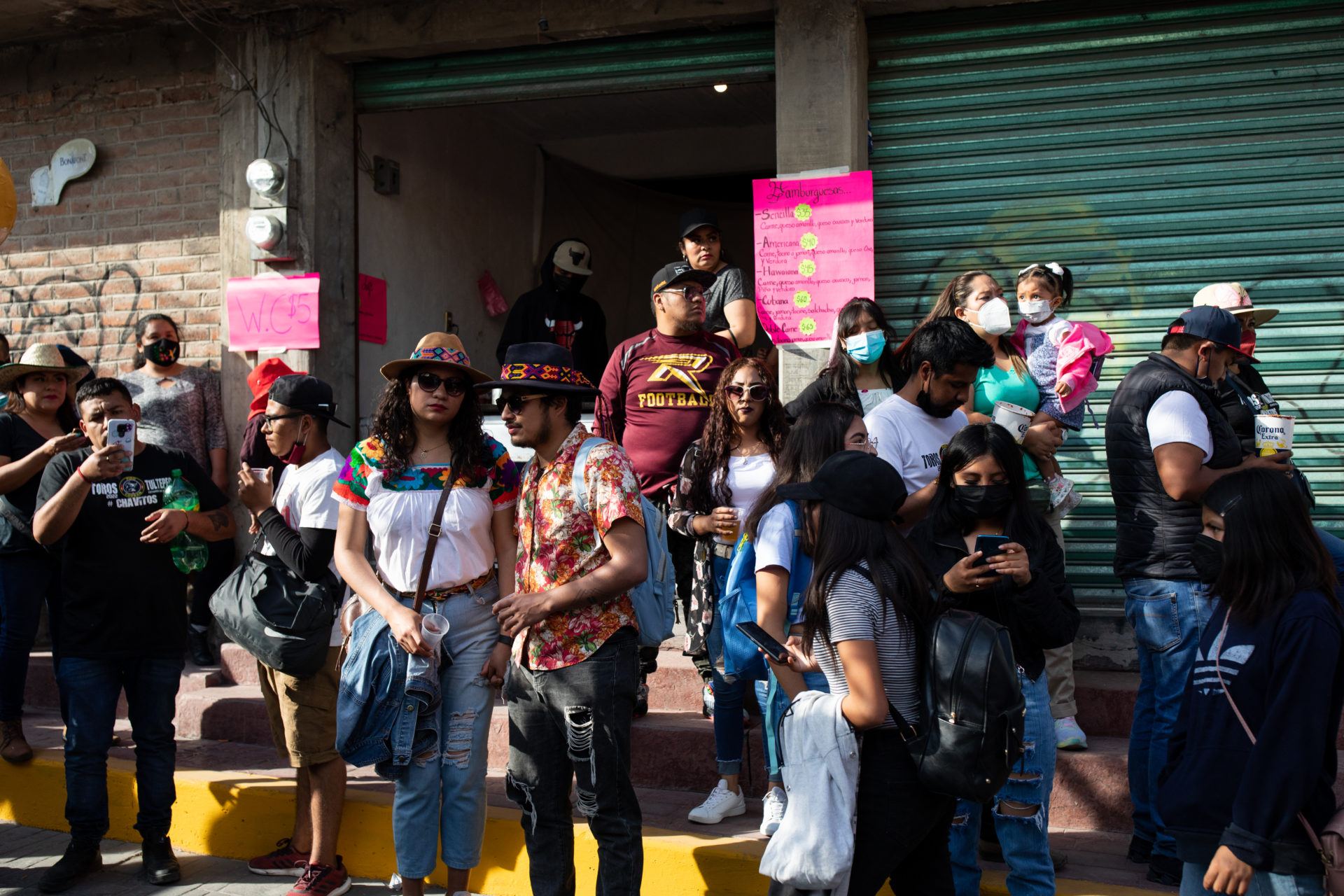
March 8, 2022 – Crowds line up on the streets of Tultepec on the day of the toros.
This year, 400 bulls and 120,000 people show up and families make a special effort to create a unique work of art: one bull has a pulque spout between his legs, another sports sunglasses and a crown, El Zorro’s horns light up and his flared nostrils spew blue smoke.
The decorative bulls on wheels are a fun ofrenda, an offering to the beloved San Juan, the patron saint of all pyrotechnics. In Catholic mythology, Juan saved patients from a hospital fire in the sixteenth century but miraculously incurred no injuries despite making several trips into the burning building. So, the bulls are a both a thank you to the saint —who Dulce affectionately calls “chaparrito” or shorty— and a prayer for protection.
His blessings will contend with an arsenal of gunpowder in Tultepec during the festival: on the day of toros alone, 380 people were injured. Dulce brushes it off, “we’re crazy” she says “you know we like the adrenalina.”
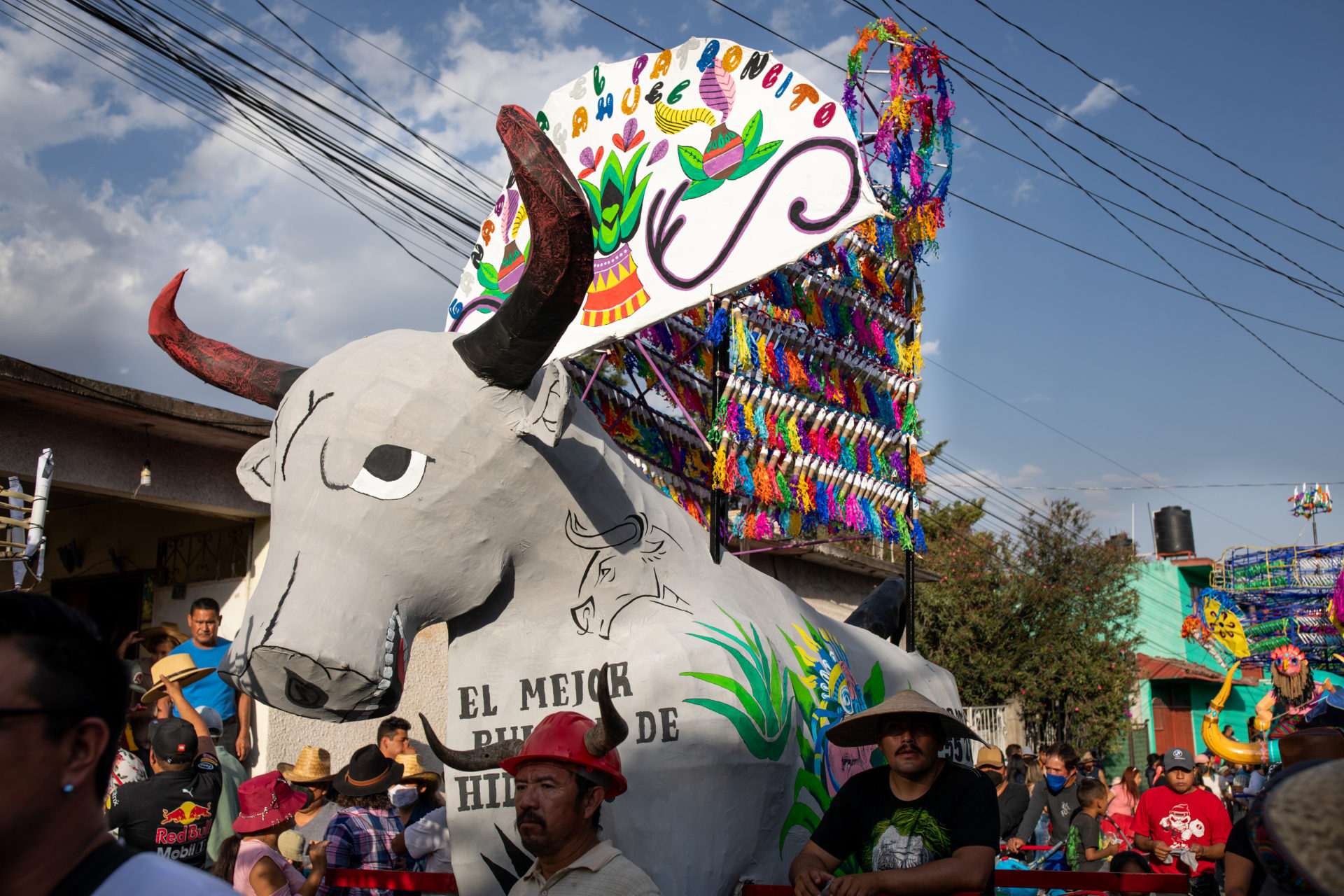
March 8, 2022 – A toro with a pulque spout between its legs on the day of the toros in Tultepec.
The love of fireworks comes with a price, “It’s our work and it’s dangerous,” she says. The chemicals in her workshop are highly flammable and a small amount of friction could ignite the materials. But Tultepec does the best they can to reduce the chances of incident and at the pyrotechnics festival and the biggest risk is getting too close to the fiery visuals on display.
The crowd’s energy during the celebration is fueled by passion for their craft. Families like Dulce’s wear matching t-shirts, they come together to push their bull through the street. When they pass an altar with a figure of San Juan, each group stops one-by-one to chant their porra in unison: an indiscernible jumble of syllables —they sound like a Texas cheerleading squad at a football game. After one family finishes the porra with a resounding “Ra, Ra, Ra!” they spin the bull as fast as they can until one teen boy flies off. The figure of San Juan looks on, a short balding Ken doll in a baptism dress, he has a pleased smirk on his face.
Left: March 8, 2022 – Ximena from Tultepec on the day of the toros. Right: March 8, 2022 – Luis, a local from Tultepec on the day of toros.
“We are Mexican,” Dulce says “we are mexicanisimos,” her heritage is the most important fact of her life. And though not all Mexicans may share in her family’s tradition of making fireworks, those in attendance find gratification in the communal catharsis and the thrill of danger. People are happy to get back to partying after two years of pandemic shut-downs. Families of all ages turn out —the ones not in matching t-shirts wear their best outfits instead. A parade of tattooed and mohawked people make their way through town, in short shorts or leather pants with chains on their waists. One group of friends catwalk single-file in a sort of cholo-inspired fashion show.
Dulce says about her Mexican culture, “We are beautiful… we have our charm… above all because we love all the people who come to visit us. Those who arrive here, and wherever they come from.” She wants visitors to feel included, she enjoys the diversity of experiences travel invites.
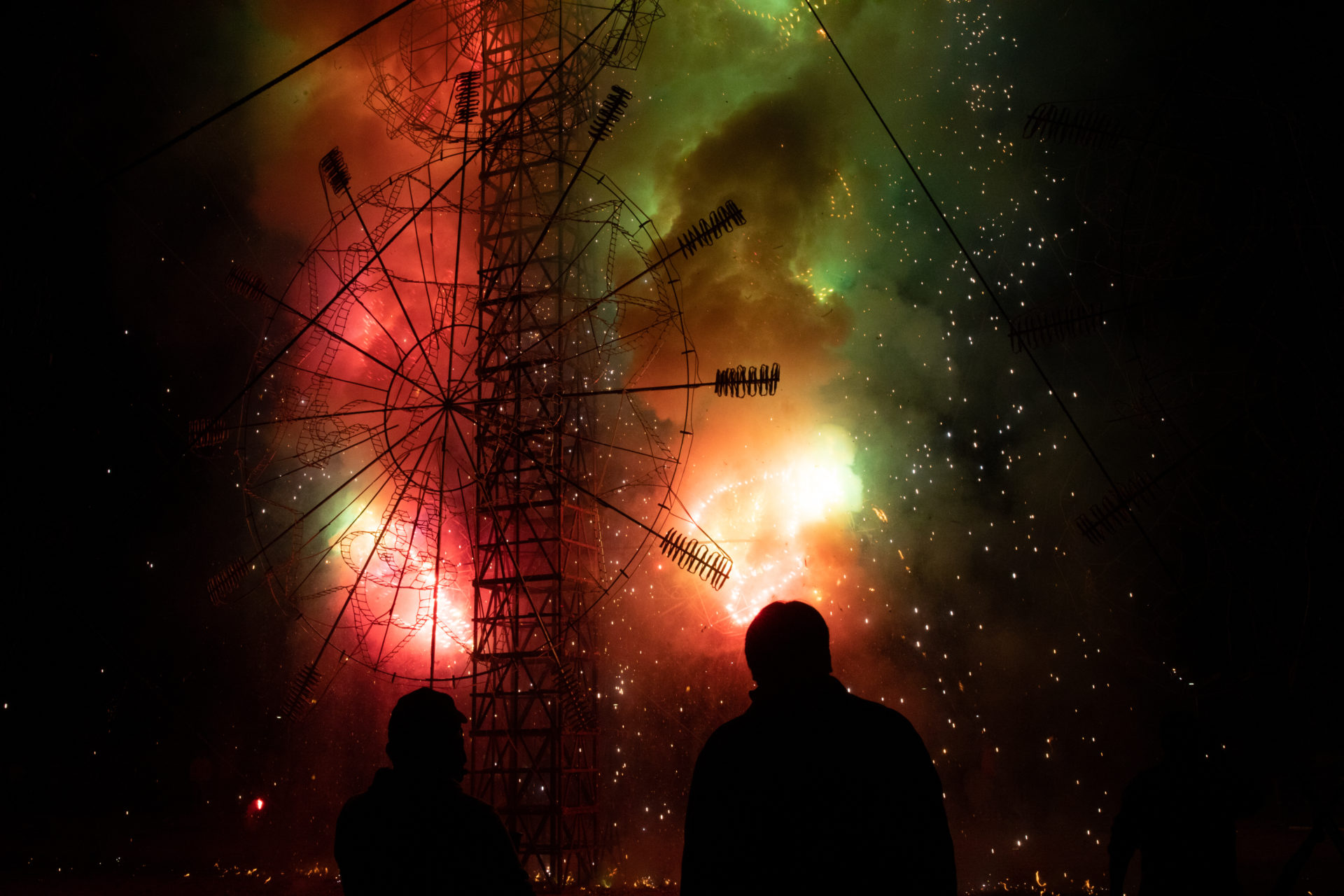
March 5, 2022 – The Castillos competition in Tultepec.
The annual festival hosts guests at daily events for 10 days but the main attractions are the castillos (or towers) and the toros. During the castillos competition (held on March 5 this year) crowds looked on as 30 meter-tall structures of fireworks explode in succession, their bursts choreographed to a barely-audible soundtrack over the whirring slow-burning explosions —as the smoke settles, spinning figures in multicolored flames came into view. Teams from Italy and Argentina joined the contest against Mexican towers.
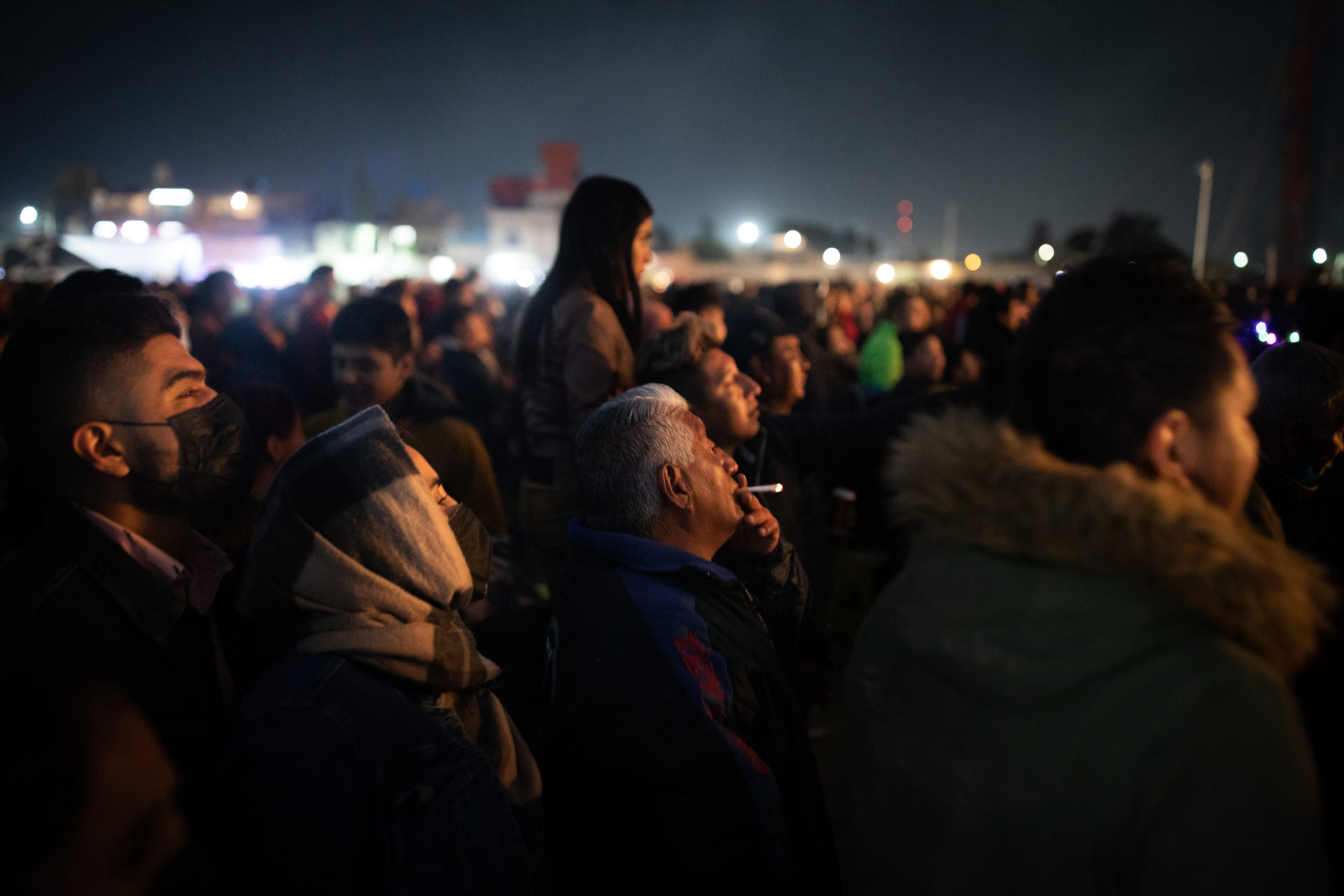
March 5, 2022 – The crowd looks on at the Castillos competition in Tultepec.
If you want to get as close to the action as possible without making the trip to Tultepec, check out “Brimstone and Glory” a documentary by Viktor Jakovleski. The 67-minute film includes slow motion footage of pyrotechnics, drone images of the town and follows one technician as he free climbs the scaffolding of a castillo with a Go-Pro strapped to his forehead —the viewer feels the vertigo of the castillo’s stance over town from his point of view. On the night of competition, we feel like we are there, peering through a fisheye lens as he sets the tower ablaze with a cigarette. The film also offers an intimate portrait of one little boy as he grapples with his perilous birthright. Most locals in the film proudly proclaim to have “gunpowder in their blood.” In Tultepec, even the birthday candles are fireworks.
This is an obsession Dulce understands. Five days a week she ends her nursing shift at a clinic an hour away, then drives to pick up her youngest daughter and heads to her workshop. There, she makes the sign of the cross to an image of San Juan before sitting down to make fireworks by hand, until late at night. While she works, her three kids have dinner and do their homework; a shiny satin Mexican flag decorates the bare cinderblock wall, “it feels more like home than my house,” she says.
The procession through town on the day of the toros leads to the final event of the night. Just after sunset, the open esplanade is crammed with a sea of people. When a toro finally makes it to the field for its quema or burning, it is wheeled through the masses without ceremony. With its many followers in tow —running alongside or helping to push it— the toro will amble through the crowd, shaking on the uneven dirt. Once lit, fireworks fly high into the air from its trunk, others shoot out sideways making a hissing sound snaking through the crowd. The silhouettes of jumping bodies undulate against the blazing backdrop —a constellation of sparks.
After hundreds of bulls, El Zorro is the last quema of the night.
Dulce and her family push past the crowd, the tianguis, and the firetruck which doubles as a lookout perch for dozens families and teens. They make it to a spot in the middle of the mass of people and light the bull’s towering saddle of explosives. While male members of her family push El Zorro around, people jump and run, trying to avoid the flames. As the bull goes out in a blaze of thundering glory, Dulce screams and hops up and down. For those few seconds she can only hear the deafening explosions and hissing sounds. As if time stood still, she forgets everything else.
“You’re there in the middle of that danger, hoping not to get burned,” she says, during the quema she knows there is no where else she’d rather be. It’s her release —the fireworks go off and “you do whatever you want,” she says.
After the quema, musicians play a few more tunes from their oboes and clarinets before the night ends at around 2 A.M. Up above, wisps of cotton candy fly like off-season tinsel from the power lines in the warm night breeze. And locals from Tultepec start looking forward, once again, to next year.
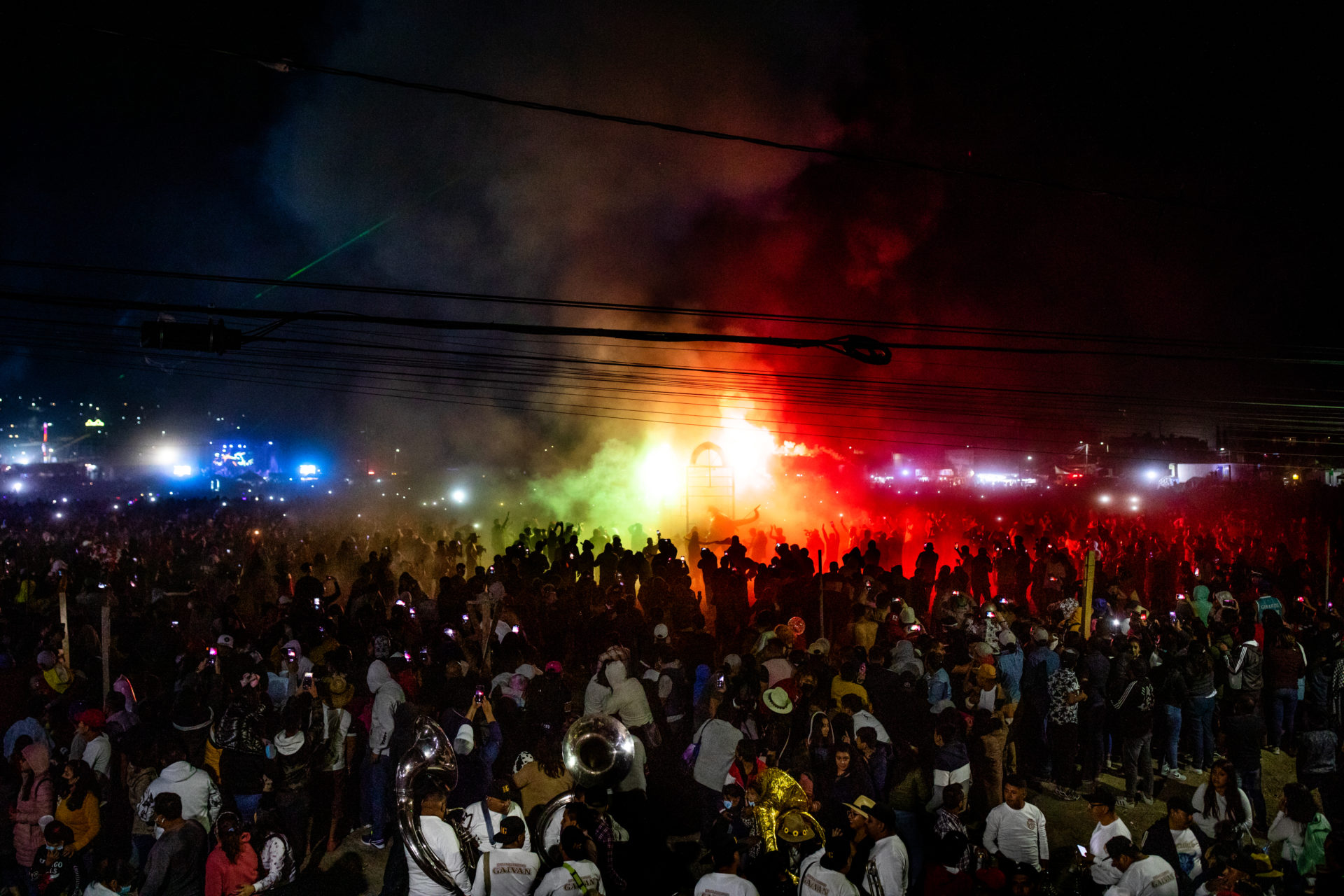
March 8, 2022 – A quema on the esplanade the day of the toros.
